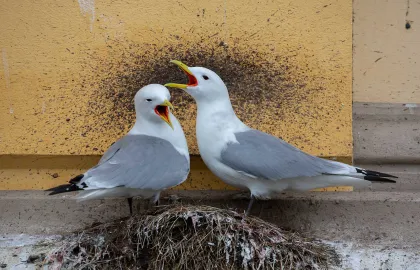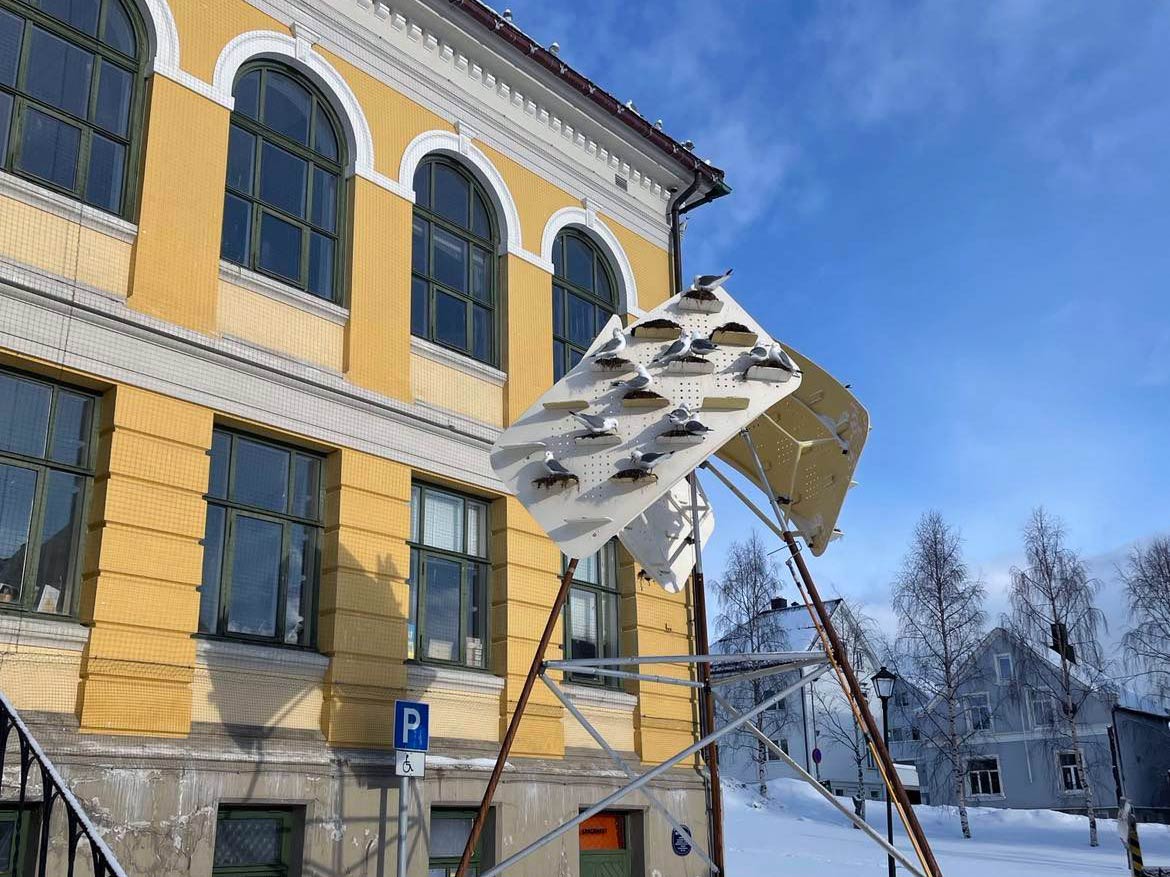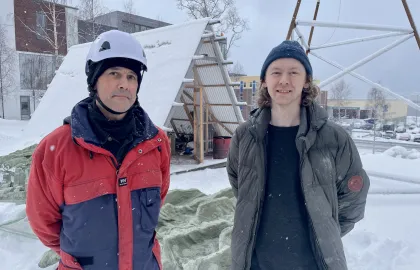
«Urbane krykkjer» – mobile krykkjehotell i Muséparken
Sammendrag
Et nyskapende prosjekt for å skape god sameksistens mellom oss og de rødlistede måsefuglene.









Krykkjer er måsefugler som hekker i flokk. Deres naturlige habitat er i fuglefjell på kysten. På grunn av miljøendringer trekker krykkjene inn til urbane strøk, der de finner trygge omgivelser for å hekke og oppdra ungene sine. I motsetning til slektningene sine, gråmåsen og fiskemåsen, henter krykkja maten sin til havs, og spiser ikke «bymat» som pølser og kebab.
Mobile hotell
De siste årene har mange krykkjepar hekket på Tromsø kunstforening. Hekkingen medfører både lukt og leven, og skade på bygget. For å unngå hekking på bygget har vi nå bygd «hoteller» til krykkjene, som vi håper de vil trives i.
De tre mobile krykkjehotellene plasseres først like i nærheten av de tidligere hekkeplassene, for å få krykkjene til å akseptere disse. Deretter skal de flyttes lenger ned i parken, hvor fuglene er til mindre sjenanse. Her skal det settes opp et større permanent hotell.
Hvis vi lykkes med prosjektet i Musèparken, vil de mobile hotellene kunne brukes andre steder i byen.
Prosjektet er et samarbeid mellom Tromsø kommune, AT Plan og arkitektur, Norges institutt for naturforskning (NINA), Tromsø kunstforening og kunstnerne Lawrence Malstaf og Kåre Grundvåg.

Mobile tripoder
I arbeidet med de nye hekkeplassene ble det lansert en idé om mobile krykkjehotell. Konseptet innebærer at man i første omgang skal kunne plassere installasjonene nært opp til de tidligere hekkeplassene for å få krykkjene til å akseptere disse. Deretter er planen å flytte installasjonene sakte, men sikkert til en del av Musèparken hvor krykkjenes tilstedeværelse reduserer konflikter og er til mindre sjenanse.
For at de nye installasjonene skal være flyttbare er vekt en hovedutfordring. Flere løsninger ble diskutert og man falt til slutt ned på å teste ut en lett triangelkonstruksjon, kalt tripod. Tripoden skulle være rammen som hekkeplassene skulle festes til. Selve rammekonstruksjonen er satt sammen av stål og aluminiumsrør hvor hvert av de tre beina har fått en sinnrik løsning som muliggjør flytting på snø og is, justere lengden, samtidig som disse kan forankres til bakken når ønsket posisjon er funnet.
Redeplatene er foreløpig utviklet i to varianter:
- 9mm kryssfiner som er buet for å oppnå ønsket styrke og stivhet. Redehyllene er innsatt med sand i malingen for å oppnå en ru og bedre egnet overflate for redeetablering.
- 50mm isolasjonsplater som er formet og limt sammen og deretter dekket med jute. Redehyllene blir som en imitasjon av fjellveggpartier Alle tripodene blir supplert med fjorårsreder som er tatt vare på og som man håper skal tiltrekke krykkjene. I tillegg til remonteringav redene så planlegges det å plassere ut støpte krykkje-imitasjoner for ytterligere å tiltrekke seg fuglenes oppmerksomhet.

Fast installasjon
Del to i løsningsforsøkene på krykkjeutfordringene er å etablere en større fast installasjon lengre ned i parkens søndre del mot Strandvegen og tunnelinnslaget. Håpet er å få samlet de urbane krykkjene i dette området, og at dette kan bli et kunstig fuglefjell som kan være et permanent uforstyrret hekkested samtidig som det blir en ny attraksjon i Musèparken.

Alle tiltakene er nybrottsarbeid og del av et forskningsprosjekt i samarbeid med Norsk institutt for naturforskning, NINA. Krykkjeutfordringene er betydelige i hele sentrumsområdet. Hvis man lykkes med prosjektet i Musèparken vil disse «learning by doing»-erfaringene kunne overføres til andre steder i byen, og ellers i landet. Krykkjene er kommet for å bli og vi må finne løsninger for denne truede fuglearten slik at varig vellykket sameksistens kan bli en realitet i Tromsø.

Fakta om krykkja

Hvorfor flytter krykkjene til byen?
Det er flere årsaker til at krykkjer blir urbane. Klimaendringer har ført til næringssvikt, tøffere værforhold på yttersiden av kysten, og økt predasjon. Fellesfaktoren er hekkesvikt over lang tid som følge av store miljøendringer ved fuglefjellene. Krykkjenes måte å tilpasse seg disse store miljøendringene på, er å flytte hekkeplassen til et tryggere sted. Og byer og menneskeskapte strukturer ser ut til å være tryggere. For at arten skal overleve avhenger de av forutsigbare og trygge hekkeplasser. I flere tiår har antallet krykkjer sunket drastisk, og det gjør at de som er igjen blir mer utsatt for angrep fra rovfugler. I byer får de beskyttelse til å fø fram unger.
Inne i byen bygger krykkjene ofte reir på husvegger, som en erstatning for fuglefjellene de normalt ville brukt. Krykkjene spiser bare mat den finner i havet og stjeler ikke «bymat» som pølser og kebab, som de andre måseartene gjerne gjør her i byen. Likevel er det en utfordring siden de medfører mye lyd og lukt og skiter ned husveggene der de hekker. Derfor er det gjort mange tiltak på bygninger for å hindre at de hekker, samtidig som det bygges krykkjehoteller slik at fuglene skal ha en alternativ plass å bygge reiret på hvor de kan være i fred.
En sterkt truet art
Krykkja hekker langs norskekysten, fra Rogaland til Finnmark og på Svalbard, men antallet i de norske koloniene har sunket med mellom 50 og 80 % de siste 30 årene. Derfor har arten status som sterkt truet (EN) på den norske rødlista for arter. Også internasjonalt er krykkja sterkt redusert i antall, og har nå status som sårbar (VU).
Krykkja benytter seg helst av samme reir eller reirplass, år etter år. Derfor er det viktig for dem å komme tidlig tilbake til hekkeplassen for å forsvare denne. De overvintrer ute i Nord-Atlanteren, og særlig mellom Grønland og Newfoundland. I Tromsø kommer de gjerne allerede i midten av februar, selv om eggleggingen ikke skjer før i mai.
Les mer i Norsk rødliste for arter
